|
 Gallacea eburnea Gallacea eburnea
SynonymsHysterangium sp. 4
BiostatusPresent in region - Indigenous. Endemic
Images (click to enlarge)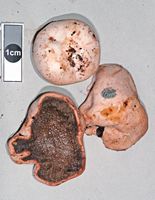
Owner: J.A. Cooper | 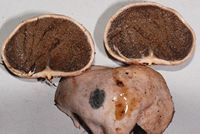
Caption: upper - columella. Lower left: FeSO4. lower right: KOH.
Owner: J.A. Cooper | 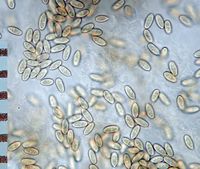
Caption: spores (melzers)
Owner: J.A. Cooper | 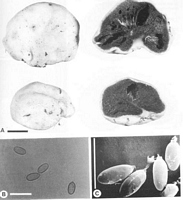
Caption: Fig. 2 Gallacea eburnea. A, Basidiomata exterior and in section (PDD 48798). B,
Basidiospores by bright field (PDD 48798). C, Basidiospores by SEM (PDD 48798). Scale:
1 cm (A), 10 µm (B, C). | 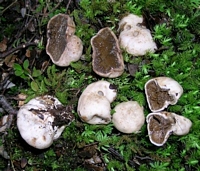
Caption: fruitbodies in moss
Owner: J.A. Cooper | 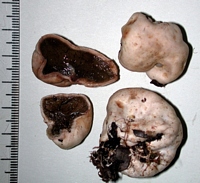
Owner: J.A. Cooper | 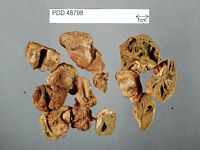
Caption: Dried type specimen
Owner: Herb PDD | 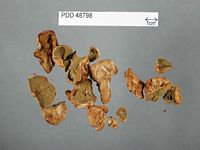
Caption: Dried type specimen
Owner: Herb PDD | |
Article: Castellano, M.A.; Beever, R.E. (1994). Truffle-like Basidiomycotina of New Zealand: Gallacea, Hysterangium, Phallobata, and Protubera. New Zealand Journal of Botany 32(3): 305-328 (http://www.rsnz.org/publish/abstracts.php).
Description: Basidiomata up to 6 cm diam., globose to subglobose or irregularly lobed, larger
sporocarps irregularly grooved and dimpled, white to pale yellow or pale pink when
fresh, bruising µmkish brown, drying pale yellow brown to brown, surface glabrous,
sometimes cracking to expose gleba; EtOH slowly pale µmk, FeS04 blue green, KOH
pale yellow orange, Melzer's reagent negative. Gleba dark olive to olive brown, locules
irregular to radially elongate, partially filled, developing schizogenous cavities up to 2
cm across. Rhizomorphs evanescent, numerous, branched, attached to indented base,
concolorous with peridium. Columella dendroid, with up to 5 primary branches in
longitudinal section, gelatinous, milky translucent, base traversed by strands of opaque
white tissue arising from peridium. Taste nil to slightly peppery. Odour acetylenic after
incubation. Peridium not separable from gleba, 575-750 µm thick, 2-layered; epicutis
75-150 µm thick, of pale brown, thin-walled, somewhat gelatinised, interwoven to
subpericlinal hyphae, 1-3 µm diam., clamp connections absent; subcutis 500-600 µm
thick, of hyaline, thin-walled, irregularly shaped isodiametric inflated cells, to 25-50 µm
diam., clamp connections absent. Trama 150-225 µm thick, of hyaline, collapsed,
loosely interwoven hyphae, 1-4 µm diam., in a gelatinised matrix, clamp connections
absent. Basidia rehydrating poorly, thin-walled, hyaline, 6(-7)-spored. Spores smooth,
(6-)7-9 x 3-4 µm, oblong, sometimes slightly asymmetric; apex obtuse, base with a
distinct sterigmal attachment 1 x 1 µm; wall <0.5 µm thick. Utricle absent. Spore colour
in KOH pale green singly, pale olive brown in mass.
Habitat: Habitat: hypogeous or subepigeous in Nothofagus forest, putatively mycorrhizal with
Nothofagus fusca, N. menziesii, N. solandri, and N. solandri var. cliffortioides. Season:
February to September.
Distribution: New Zealand.
Notes: ETYMOLOGY: From Latin ebumeus, in reference to the predominantly white colour of
the fresh peridium.
REMARKS: Gallacea eburnea differs from G. dingleyae in its smaller spores and thicker
peridium. G. avellana Pat. from New Caledonia resembles both these species in its white
peridium, but differs in its non-olivaceous reddish gleba and smaller (5-6 x 3 µm) spores.
Chu-Chou & Grace (1983) illustrate G. eburnea as "Hysterangium species 4".
Article: Gadgil, P.D. (in association with Dick, M.A.; Hood, I.A.; Pennycook, S.R.) (2005). Fungi on trees and shrubs in New Zealand. Fungi of New Zealand. Ngā Harore o Aotearoa 4: xi + 437 p. Hong Kong: Fungal Diversity Press.
Description: Type: Mycorrhizal Fungi; Description: Basidiomata hypogeous or subepigeous, globose to subglobose, white to pale yellow, pinkish brown when bruised, up to 60 mm in diameter; rhizomorphs numerous, evanescent; peridium composed of two layers, pale brown in section. Gleba dark olive to olive brown; locules irregular or radially elongate, partially filled with basidiospores, collapsing to form cavities up to 20 mm across; columella branched. Basidiospores oblong, 0-septate, 6–9 × 3–4 μm, smooth, pale green.
Distribution: Distribution: Taupo, Nelson, Buller, Fiordland, North Canterbury.; 1st Record: Chu-Chou & Grace (1983b: as Hysterangium sp. 4, pro parte).
|